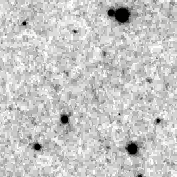| Observation data Epoch J2000.0 Equinox J2000.0 (ICRS) | |
|---|---|
| Constellation | Pisces |
| Pronunciation | /vænˈmʌnənz/)[1] |
| Right ascension | 00h 49m 09.89841s[2] |
| Declination | +05° 23′ 18.9931″[2] |
| Apparent magnitude (V) | 12.374[3] |
| Characteristics | |
| Spectral type | DZ8[4] |
| U−B color index | 0.064[3] |
| B−V color index | 0.546[3] |
| V−R color index | 0.268[3] |
| R−I color index | 0.4[5] |
| Astrometry | |
| Radial velocity (Rv) | −12±7[6] km/s |
| Proper motion (μ) | RA: +1,231.325[2] mas/yr Dec.: −2711.830[2] mas/yr |
| Parallax (π) | 231.7800 ± 0.0183 mas[7] |
| Distance | 14.072 ± 0.001 ly (4.3144 ± 0.0003 pc) |
| Absolute magnitude (MV) | 14.21±0.03[8] |
| Details | |
| Mass | 0.67±0.01[9] M☉ |
| Radius | 0.01[10] R☉ |
| Luminosity | 0.00016[9][8] L☉ |
| Surface gravity (log g) | 8.16±0.01[9] cgs |
| Temperature | 6,130±110[8] K |
| Age | 3.45±0.36[a][8] Gyr |
| Other designations | |
| Database references | |
| SIMBAD | data |
Location of van Maanen's Star in the constellation Pisces | |
Van Maanen 2, or van Maanen's Star, is the closest known solitary white dwarf to the Solar System. It is a dense, compact stellar remnant no longer generating energy and has equivalent to about 68% of the Sun's mass but only 1% of its radius.[11] At a distance of 14.1 light-years it is the third closest of its type of star after Sirius B and Procyon B, in that order.[12][13] Discovered in 1917 by Dutch–American astronomer Adriaan van Maanen,[14] Van Maanen 2 was the third white dwarf identified, after 40 Eridani B and Sirius B, and the first solitary example.[15]
- ^ Cite error: The named reference
Dickinson2012was invoked but never defined (see the help page). - ^ a b c d Cite error: The named reference
GaiaDR2was invoked but never defined (see the help page). - ^ a b c d Cite error: The named reference
mnras403_4_1949was invoked but never defined (see the help page). - ^ Cite error: The named reference
vizierIII_235Bwas invoked but never defined (see the help page). - ^ a b Cite error: The named reference
simbadwas invoked but never defined (see the help page). - ^ Cite error: The named reference
Lindegren_Dravins_2021was invoked but never defined (see the help page). - ^ Brown, A. G. A.; et al. (Gaia collaboration) (2021). "Gaia Early Data Release 3: Summary of the contents and survey properties". Astronomy & Astrophysics. 649: A1. arXiv:2012.01533. Bibcode:2021A&A...649A...1G. doi:10.1051/0004-6361/202039657. S2CID 227254300. (Erratum: doi:10.1051/0004-6361/202039657e). Gaia EDR3 record for this source at VizieR.
- ^ a b c d Cite error: The named reference
Subasavage_et_al_2017was invoked but never defined (see the help page). - ^ a b c Cite error: The named reference
Limoges2015was invoked but never defined (see the help page). - ^ Kervella, Pierre; Arenou, Frédéric; Thévenin, Frédéric (2022-01-01). "Stellar and substellar companions from Gaia EDR3. Proper-motion anomaly and resolved common proper-motion pairs". Astronomy and Astrophysics. 657: A7. arXiv:2109.10912. Bibcode:2022A&A...657A...7K. doi:10.1051/0004-6361/202142146. ISSN 0004-6361.
- ^ Cite error: The named reference
ApJS199_2_29was invoked but never defined (see the help page). - ^ Cite error: The named reference
reconswas invoked but never defined (see the help page). - ^ Cite error: The named reference
apj571was invoked but never defined (see the help page). - ^ Cite error: The named reference
van_maanenwas invoked but never defined (see the help page). - ^ Cite error: The named reference
schatzmanwas invoked but never defined (see the help page).
Cite error: There are <ref group=lower-alpha> tags or {{efn}} templates on this page, but the references will not show without a {{reflist|group=lower-alpha}} template or {{notelist}} template (see the help page).

